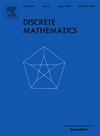Graphs that admit a Hamilton path are cup-stackable
IF 0.7
3区 数学
Q2 MATHEMATICS
引用次数: 0
Abstract
Fay, Hurlbert and Tennant recently introduced a one-player game on a finite connected graph G, which they called cup stacking. Stacks of cups are placed at the vertices of G, and are transferred between vertices via stacking moves, subject to certain constraints, with the goal of stacking all cups at a single target vertex. If this is possible for every target vertex of G, then G is called stackable. In this paper, we prove that if G admits a Hamilton path, then G is stackable, which confirms several of the conjectures raised by Fay, Hurlbert and Tennant. Furthermore, we prove stackability for certain powers of bipartite graphs, and we construct graphs of arbitrarily large minimum degree and connectivity that do not allow stacking onto any of their vertices.
求助全文
约1分钟内获得全文
求助全文
来源期刊

Discrete Mathematics
数学-数学
CiteScore
1.50
自引率
12.50%
发文量
424
审稿时长
6 months
期刊介绍:
Discrete Mathematics provides a common forum for significant research in many areas of discrete mathematics and combinatorics. Among the fields covered by Discrete Mathematics are graph and hypergraph theory, enumeration, coding theory, block designs, the combinatorics of partially ordered sets, extremal set theory, matroid theory, algebraic combinatorics, discrete geometry, matrices, and discrete probability theory.
Items in the journal include research articles (Contributions or Notes, depending on length) and survey/expository articles (Perspectives). Efforts are made to process the submission of Notes (short articles) quickly. The Perspectives section features expository articles accessible to a broad audience that cast new light or present unifying points of view on well-known or insufficiently-known topics.
 求助内容:
求助内容: 应助结果提醒方式:
应助结果提醒方式:


